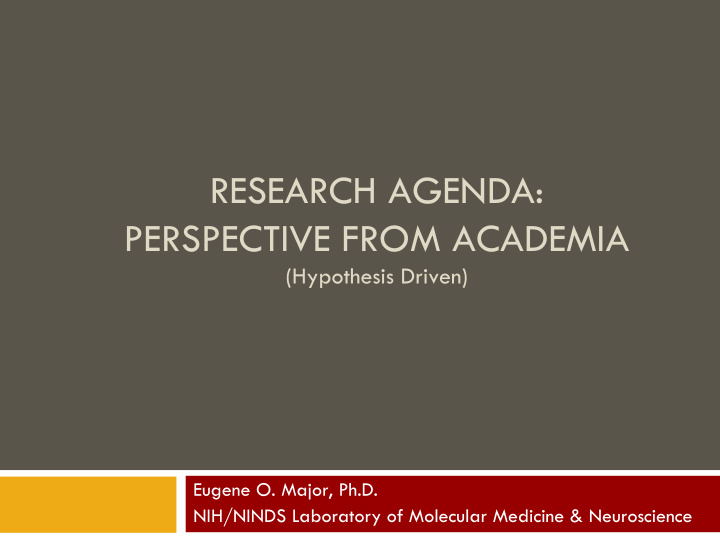



RESEARCH AGENDA: PERSPECTIVE FROM ACADEMIA (Hypothesis Driven) Eugene O. Major, Ph.D. NIH/NINDS Laboratory of Molecular Medicine & Neuroscience
Background 2 JC virus is a very difficult agent to work with Research will continue but move slowly compared with more conventional agents New research approaches may be needed such as coordinated technologies and ‘team’ investigations, that direct ‘translational’ work.
Recommended Research Areas 3 Research approaches Molecular genomics/proteomics; virus and host Viral gene regulation in specific cells i.e. glia vs neuron Immunology of therapies and host response to infection Drug Discovery Small molecules for intervention of viral growth once identified; relevant cell model for screen Vaccines, peptides, VLPs (like papilloma virus) Prophylactic Therapeutic Pre-clinical studies/clinical studies Relevant animal model for pathogenesis and intervention
Human CNS Multipotential Progenitor Cells 4 Nestin BDNF (10 ng/ml) +PDGF (10 ng/ml) 10% Serum bFGF (25 ng/ml) EGF (20 ng/ml) T3, bFGF, PDGF + growth factor withdrawal Β -III Tubulin O4/GFP GFAP Differentiated Neuronal Cells Differentiated Oligodendrocytes Differentiated Glial Cells
Recommended Research Areas 5 Research approaches Molecular genomics/proteomics; virus and host Viral gene regulation in specific cells i.e. glia vs neuron Immunology of therapies and host response to infection Drug Discovery Small molecules for intervention of viral growth once identified; relevant cell model for screen Vaccines, peptides, VLPs (like papilloma virus) Prophylactic Therapeutic Pre-clinical studies/clinical studies Relevant animal model for pathogenesis and intervention
Non-Human Primate Model 6
Recommended Research Areas 7 Research approaches Molecular genomics/proteomics; virus and host Viral gene regulation in specific cells i.e. glia vs neuron Immunology of therapies and host response to infection Drug Discovery Small molecules for intervention of viral growth once identified; relevant cell model for screen Vaccines, peptides, VLPs (like papilloma virus) Prophylactic Therapeutic Pre-clinical studies/clinical studies Relevant animal model for pathogenesis and intervention
NIH-Funded JCV/PML Research Areas 8 Number of Projects Funded Per Major Research Area FY 2008 FY2009 FY2010 Epidemiology/Pathogen 2 2 2 esis Disease/Molecular 8 10 8 Mechanisms Therapeutic/Vaccine 0 2 4 Development Cellular 2 2 2 Response/Structure Clinical Presentation/Diagnostic 3 3 3 s Immunology/Virology 9 7 5 Data retrieved from the public accessible NIH Report: http://report.nih.gov/
Comparison of NIH-Funding for JCV & HSV 9 Data retrieved from the public accessible NIH Report: http://report.nih.gov/
Summary 10 To advance research, the field needs more formal support and collaboration and needs infusion of new ideas . Additionally, recruiting new principal investigators from different fields such as rheumatology, immunology, basic neuroscientist (glial) cells, genetics and neuro-infectious diseases will help to advance the science that should inform medical research.
Recommend
More recommend